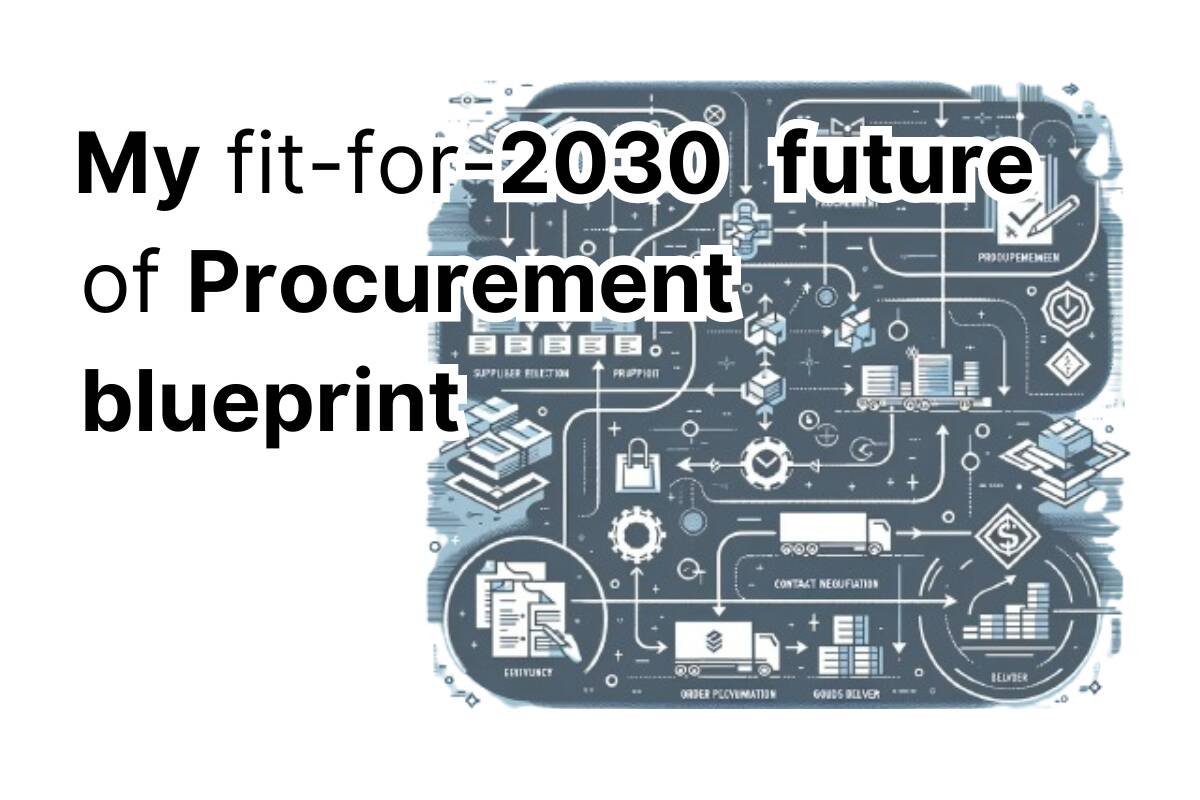Could more visionary procurement leaders be the cure for procurement teams not getting the recognition they deserve? We often don’t have the necessary organisational clout to orchestrate change. Is a lack of vision and creativity the culprit?
This is a more editorial piece compared to what we typically publish. I desperately feel that there’s an urgent need to have this debate.
We Need Visionary Procurement Leaders with a Chief Value Officer mindset
If we’re going to get the investment we need into tech, resources and training to make us a world class function in more organisations, we need more visionary procurement leaders. And by that, I certainly don’t mean more people getting a CIPS qualification.
It’s time to start replacing the technocratic, process-obsessed procurement teams. We must usher in a more visionary and value-focused group of procurement leaders and CPOs.
The Status Quo has got to GO!
I’ve borrowed this phrase from my good friend Katie McEwen but I have to say, she’s right.
Ostensibly, you can have a reasonably functional procurement team who performs everything in ERP. They run some successful tenders and negotiations, and they perennially deliver their annual cost savings targets to the business.
From the CEO or CFO’s office, it may appear that everything seems to be under control and well managed. It is, to a certain extent.
I’ve seen teams like this and met quite a few CPOs, Heads of Procurement and Directors who lead them. But they’re missing one key ingredient.
Vision.
An appetite for disruption. Not destruction – sorry Guns ‘n’ Roses fans – and a creative flair pulsating through the team.
They’re seen as successful. And in the eyes of the CFO, I suspect they are. But they’re ignoring a massive opportunity cost.
And it’s this:
How much better could they be if they had more vision, creativity, technology and A players? And what if they were prepared to fight for it, instead of rolling over at the first sign of a budget cut?
How strategic is your procurement function, really?
Most procurement teams, especially enterprise procurement teams, will typically see themselves as a strategic department.
I’m about to give you a wake-up call.
Running a few pre-planned eAuctions and refreshing your category strategies every couple of years are not the hallmarks strategic procurement team.
Most sourcing events are actually pretty tactical in nature. Very process-oriented and not agile or malleable at all.
And let’s face it, most category strategies are a box-ticking exercise. Often, Procurement struggles to get meaningful input from senior stakeholders in the business. When that happens, inevitably these category strategies rarely see the light of day.
Was it really worth Procurement Category Managers spending weeks fiddling around in Power Point for prized strategies to just sit on a siloed SharePoint site?
My definition of a strategic procurement team is something way more visionary.
It must be innovative, edgy, pushing boundaries. It must be deeply embedded with the business and with the supply base. Procurement must both challenge and support them in equal measure.
Sales has Marketing, but who does Procurement have?
Salespeople are at the sharp end. It’s a customer-focused and intensely target based role.
You could quite reasonably argue that Procurement is the other side of the coin to Sales when it comes to how we manage the supply base. But with a couple of key differences.
Firstly, we don’t have Marketing on our tag team as a creative outlet.
OK, so you can argue that we don’t need to create brand awareness and values for our suppliers. And I’d broadly agree with that. Although I do think that we must work harder with our suppliers to be a customer of choice. But that’s a discussion for another day.
However, what is chronically absent is an internal communication strategy to effectively give procurement a brand.
We’re terrible at explaining what we actually do.
If we could get this right, our much-maligned seat at the table would be a formality rather than a struggle.
Creativity is King in Modern Business
Apple didn’t become a $3 trillion business by its executives sitting around in meeting rooms pondering “what would HP or IBM do?”. They blazed their own trail.
This neatly brings me onto the topic of creativity – or lack of it – among senior procurement leaders. It’s easy here to roll out the stereotype of the rather stale, middle-aged white male. The truth is, plenty of non-white and female procurement leaders lack this creative spirit too.
How many Procurement leaders put out internal podcasts, live streams or video content to their organisations?
Town Halls are a waste of time. They’re introspective, stroking the ego of the CPO. Getting all of your Procurement team onto a Teams call to sit through 45 minutes of PowerPoint and 15 minutes of carefully screened questions is a box-ticking exercise.
They should be cross-functional and cross-departmental.
Put your Procurement team in a room together with Operations, IT or Marketing to mingle and chat informally. It will deliver so much more value.
How many Procurement leaders consider that hiring people remotely in countries where salaries are lower could give them a bigger team for the same wage bill?
We don’t have a shortage of talent. We have a shortage of vision. But even more worrying is we seem to have a dangerously big surplus of risk-aversion.
How many Procurement leaders have considered a different strategy to digitisation than just going with a legacy brand that sponsors a big conference?
Digital transformations fail because of lack of vision, and lack of creativity and a refusal to think outside of the box in terms of what is possible.
But they also fail because of lack of talent, lack of budget and lack of effective change management. This brings us onto two other important factors when considering how visionary procurement leaders could achieve more.
Why not mix seasoned Procurement Managers with Cross-Functional Moves?
Vision requires diversity. This should not mean just following identity politics. Diversity of thought, opinion and career background is equally important.
This can only be achieved by staffing procurement teams with cross-functional moves in key leadership positions and functional expert roles.
You don’t need a professional qualification and years of category or industry experience to succeed in procurement. Your attitude, mindset, adaptability and creativity should matter just as much, possibly more.
Sure, you need category experts, process expertise and folks who are adept at risk management. They will still be some of the key figures within your team.
Too many of them though, and you risk having an “identikit” procurement department.
Hiring someone from Marketing, Operations, IT or Logistics into Procurement will solidify and strengthen your team, not weaken it.
And that’s without even touching on other roles which will almost certainly belong soon to any world class procurement team:
- Data scientists
- Data analysts
- Web app developers
- Content creators
- Community managers (rebranded internal business partners)
- Generative AI prompt experts
- Supplier development managers
We’ll tackle this in another post soon, exploring how procurement teams will look in 2030.
CPOs must become bolder, fight for their budget and headcount
Let’s get real.
Most of the organisation considers procurement to be a back office function and a cost centre. Only a select few senior leaders outside of our profession really recognise their CPO to be the Chief Value Officer.
Indeed, it’s more commonly recognised that the CFO may take that role.
If Procurement is ever going to get the technology budget and the ability to adopt a more sales-esque approach to compensation, somebody is going to have to fight for it.
That somebody is the CPO.
We’ve all benefited from their assertiveness and negotiating prowess when they’ve confronted suppliers in difficult discussions. And yet, somehow, this seems to evaporate into thin air the moment they get near the boardroom.
CPOs must coach their teams to also be equally assertive when it comes to managing internal stakeholders. Our customers are the end consumers of the products or services our organisations sell. In public companies, our customers are also the shareholders.
Stakeholders, on the other hand, are our equals. We are not subservient to them. We need to build trust with them and show them the value we can deliver.
There is, however, an important caveat. This strategy only works when procurement objectives are in lockstep with those of the wider business. We can’t bulldoze a cost-savings-above-everything-else strategy onto the organisation.
How can organisations attract visionary Procurement Leaders?
This is almost a separate article in itself, but to round off this post, let’s look at how this can be achieved:
1. Keep HR at arm’s length when writing job descriptions
Hire a copywriter instead to make it sound exciting. The best job descriptions stand out like a shining diamond compared to most of the drivel. Just let HR take care of the legal and regulatory requirements in the job posting.
2. Be flexible with salaries
Look at any successful football team as an example. They see the value in having a malleable wage structure to enable them to attract the superstars.
3. Embed procurement at the heart of strategic decision making
I know, easier said than done, right. And usually requires sponsorship from the CEO.
It’s key though for long-term success. You can have a team of visionaries, but if corporate politics shoves then into a back office function, then you’re going to have high levels of attrition.
4. Invest in training and personal development for your team
That doesn’t mean an annual negotiation training refresher and the box-ticking Code of Conduct yawn fest. Invest in real skills beyond traditional procurement staples. Give them an understanding of wider Finance or Supply Chain topics. Enable those who are that way inclined to learn Python, or to build no code apps.
5. Hire people from startups and genuinely world-beating companies
There is entrepreneurial flair running through startups. Visionary thinking and cutting edge business practices are commonplace in big tech. Copy the best, not your average performing competitors.


